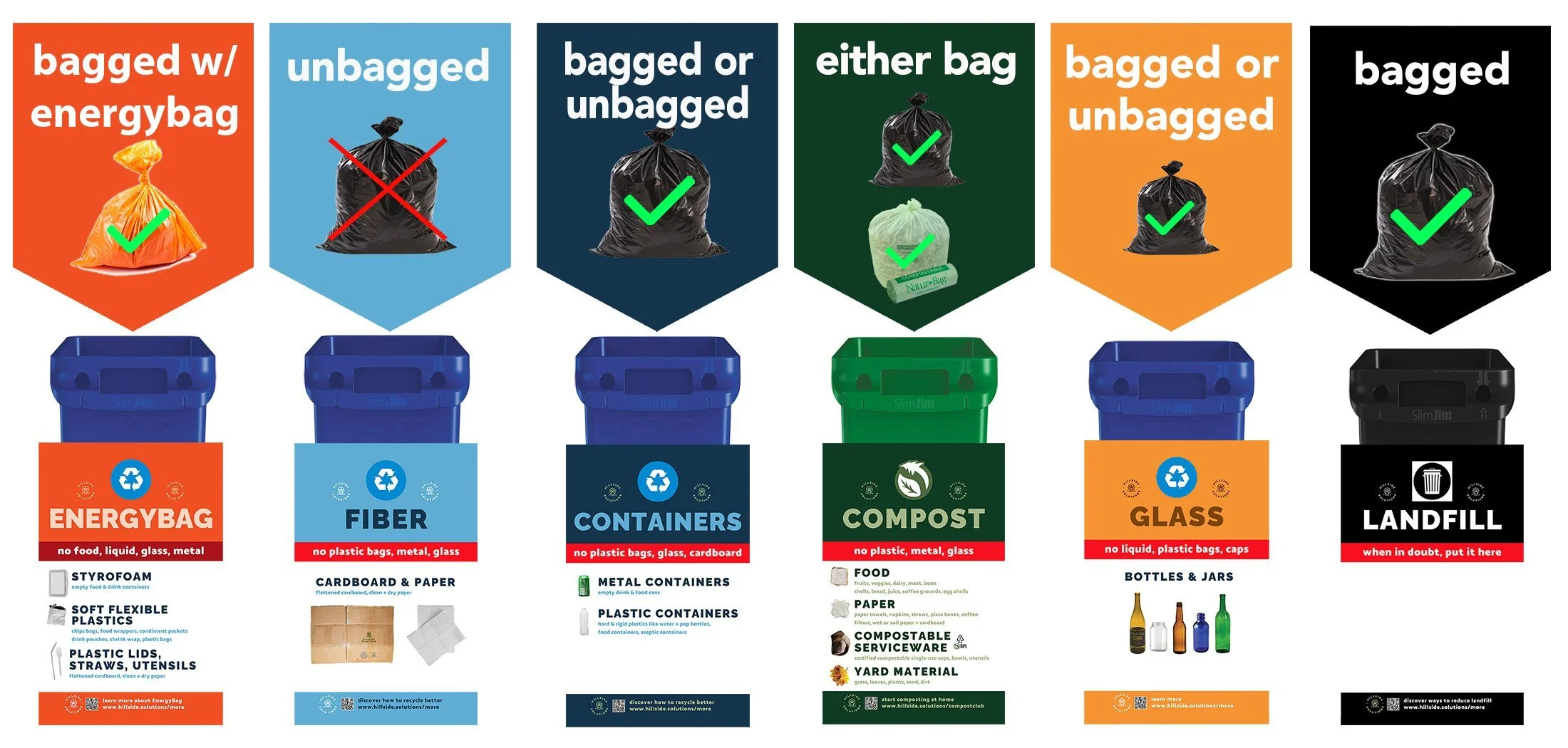How to Throw a Low Waste Party
Trash might be the last thing on the list, but it's the first of ours. Use this guide to plan a small low waste party.
Throwing an epic shin-dig doesn’t have to leave your garbage man workin’ extra hard. There are so many easy, economical ways to reduce food waste & single-use items.
Keep the 6 R’s in mind
Refuse unnecessary party expenses or add-ons that will end in the waste - balloons, plastic toys, bottled water and cheap party favors.
Reduce waste by avoiding individually wrapped food and disposable dishes. Use Save the Food’s Guest-imator tool to reduce food waste. It helps plan the amount of food you really need to feed guests.
Reuse dishes, cloth napkins, and silverware. Borrow items from neighbors or shop second hand if you don’t have enough.
Repurpose things you already own (and save money), like empty wine bottles to hold flowers for center pieces.
Recycle bottles and cans curbside. And if you must, recycle single-use silverware through the Hefty Renew program.
Rot means to “compost” organic waste, like leftovers and napkins.
Planning & Event Sourcing
Zero waste happens when 90% of the waste generated converts to valuable resources via recycling or composting. Planning and implementation of a better waste management system makes it happen.
Plan a pre-party meeting with everyone to get on the same page...even if the planning committee is only you.
Food: Serve up food from an eco-friendly restaurant or make your own. Use fresh ingredients, minimize packaging, and control portions to reduce waste. Exist Green (Omaha's first & only zero-waste boutique) will help with most of that.
Invitations: Sending an invite via snail mail is so old school (and not in a cool way). Create an "event flyer" on Canvas and email/text the flyer to guests.
Plates, Napkins, Silverware: Single-use plastics aren't "it." Avoid at all costs. Use reusable items when possible or purchase compostables. Peep the packaging for a "BPI-certified" label to ensure it's kosher to compost with us. Buy from Larson Supply Co or CostCo.
Decorations: Hard pass on Amazon balloons and Dollar Tree gaud. Use what you already have, ask on Buys, Sell, Nothing groups, Repurpose Good Will treasures or rent items from The Party Bar.
Gifts: Time together is the best gift. If you must bring something, handmake it or shop local. Pro-tip: The best way to someone's heart is through their stomach. So, bring food to share.
How to Plan a Low Waste Party
Step #1: Identify waste stream needs
What will your guests be tossing out? Here are the different recommended waste streams to set up:
Compost: for food, paper, and compostable service wares
Recycling: for plastic + metal containers, cardboard, + paper
"Hefty ReNew™ : for hard-to-recycle plastics, like chip bags and plastic utensils
Glass Recycling: for empty bottles + jars
Landfill: for everything else
Tip: No need to put out a glass recycling bin if there will not be glass to recycle.
Step #2: Find waste bins
“Use what you got.” You have more waste than normal and might need to transport it to recycling centers or compost sites around town. Make the move easy! We find it easiest to choose bins that fit in your vehicle and snap shut. You don’t want your recyclables flying around while driving down Dodge. Not sure where to find bins? Check out our blog here.
Step #3: Find a good spot inside your home for the bins
Pick a spot in a high-traffic area. Place bins together to create waste a mindless activity. When a container is by itself, regardless of the material it’s supposed to collect, most people see a trash can. If they see 2 or more containers near each other with different colors and big signs, it makes them mindful to the process. Use a small garbage bin to collect landfill waste when possible.
Step #4: Print off big signs & place above the bins.
The tired practice of slapping a recycling logo on something and assuming everyone will know what to do isn’t working out. Successful party planners assumes nobody knows what to do, then creates a safety net. Label the bins. Put the posters where the eye naturally travels, such as above the container or on the counter if it’s a pull-out drawer. Don’t make your own poster (which can lead to confusion). Use our signage for free and watch our hack video on how to print at Kinko’s on the cheap.
Step #5: Pick out liners
Pick out your liners. Outdoor containers that are emptied by the waste hauler have restrictions on what types of liners they accept. If you don’t follow instructions, recycled/composted material may go to the landfill. While you can use plastic liners inside your bins to collect recyclables and compostables, avoid putting plastic bags into recycling & composting carts or dumpsters. There are two exceptions to the above rule. Hefty Renew Bags must be used when you want to recycle soft plastics, and shredded paper for recycling must go in clear plastic bags. Our guide goes into detail about where to purchase.
Use the right liners
Step #6: Accurately empty inside bins into outside bins
People that “take out the trash” sometimes put materials into the wrong bins, causing recycling & composting to be landfilled. Make sure to follow the below guide to ensure that doesn’t happen to you.
Step #7: Contamination Prevention
Compost bins must contain little contamination since this material goes to the farm to turn into nutrient-dense soil to grow our food. Even so, contamination in our single-stream recycling carts reduces the value of recyclable materials and can lead to their disposal (landfill) rather than their use in new products.
Round up volunteers to monitor and guide guests on the sorting process. Train beforehand so they know how it works. Ensure they have proper gear, like gloves or a grabber, in case they need to be removed from the event. It’s best to have one volunteer per zero-waste station.
Step #8: Track Progress
"It's not a phase, Mom. I'm eco-friendly for life!"
Weight out material and do the math to see how much you've saved from the landfill. Remember - you've achieved zero waste if it's less than 10%. The only real goal is to try to reduce waste. Either way, we want to hear your success story. So, share the success online and tag us.
Step #8: Identify where to take waste, drive it over there & empty containers
Compost: Subscribe to Compost Club to access over 60+ drop-off sites while completing the loop by getting soil back.
Small events = Compost Club Host Site Approved
Large events = Drop off at our Ashland or Downtown location
Call a food rescue organization, like Saving Grace, before the event to make arrangements. They can help you create a system to separate out quality, edible food to fill bellies and not the landfill.
Glass Recycling: Bring empty bottles + jars to an Omaha drop-off site. You'll find a purple container for glass and a separate green container for all the recyclables. A single purple container collects all colors of glass bottles and jars.
Recycling: From Elkhorn to South 60th Street, several "large green bins" or Full-Service drop-off locations exist for your plastic containers, metal containers, cardboard + paper through the Omaha curbside collection program.
"Hefty ReNew™: Place hard-to-recycle plastics, like chip bags and styrofoam, inside orange bags. Then, tie it up and toss it into the "large green bins" or Full-Service drop-off locations. Materials will be converted into building materials.
Landfill: There's little trash left over...place it in your curbside landfill waste cart. You did good, kid!
Step #10: “Talk trash” on social media
To help usher in a new era, inform guests why it's a zero-waste event by creating a link on your e-Invites or noting promo materials. Explain the benefits. Their buy-in is crucial!
Tell guests to bring anything they'd like - food, games, etc. - as long as it doesn't end up in the landfill.
Be the host that announces when all guests are together. Say: "To minimize our waste, please ensure all utensils, plates, cups, and food waste make it to the compost bins."
Label zero waste event stations and bins with instructions. Find signage here.







